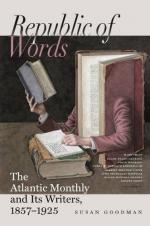This period of the painter’s experience was brought to a close by the better one of a summer residence at Pieve di Cadore, a village among the Friulian Alps. Thither he might have gone merely to make a pilgrimage to the birthplace of Titian; for other reason than that he stayed in Cadore. He stayed for life, truth, and correction, and he found all. No other place on the continent could have afforded Mr. Tilton the benefit that this mountain village did. Here was no ambiguity, no optical illusion, but frank; ingenuous Nature. The peaks which guarded the valley were clear and immutable. They suffered no conflicting opinions; accident had done little to disguise, their true character, but Nature held them as specimens of the essential in mountain structure. That the lesson of these peaks might not be forgotten, the student finds them copied accurately in nearly every landscape painted by Titian. The magnificent one in “The Presentation in the Temple” was his favorite. The sketches of this period show that the artist’s attention was divided between the study of these hill forms and of the luxuriant vegetation of the sloping fields and pastures so characteristic of Swiss scenery. Cadore is most richly endowed in this respect. The hill-sides are burdened with flowers, many of which are large and of tropical splendor. The green of the broad fields is modified by the burden of blossoms. We have seen against the background of one of these steepest fields what seemed to be a column of delicate blue smoke wreathing up the hill-side. In reality it was a bed of wild forget-me-nots, which marked the course of a minute rill. Under such influences as these, a man born to be a painter, to whom Art is all, whose hand never fails to execute, and whose mind has risen above any erroneous combination of principles which may have checked his progress toward the greatly excellent, must find himself with new strength, a chastened imagination, and broader conceptions of his art.
The results of Mr. Tilton’s labors since the summer in the Alps prove that such was the effect upon him. His pictures have of late occupied nearly every class of Landscape Art. The works now wrought in his Roman studio are indicative of great changes in feeling, and are marked by surprising improvements in execution. Yet the individuality of the artist is impressed upon every canvas. The changes to which we refer are these,—foregrounds suggested by or painted from living forms. In one view of Nemi we saw a superb black, gold, and crimson butterfly resting on a flower. Yet these foregrounds require more strength, more “body,” more of that which artists achieve who achieve nothing else. We notice far more individualism in tree forms. The ideal tree, that is, the tree as it should be, and the conventional one coming against the sky on one side of the composition, the one bequeathed by Claude, have given place to Nature’s homelier types. The question as to the meaning of passages




